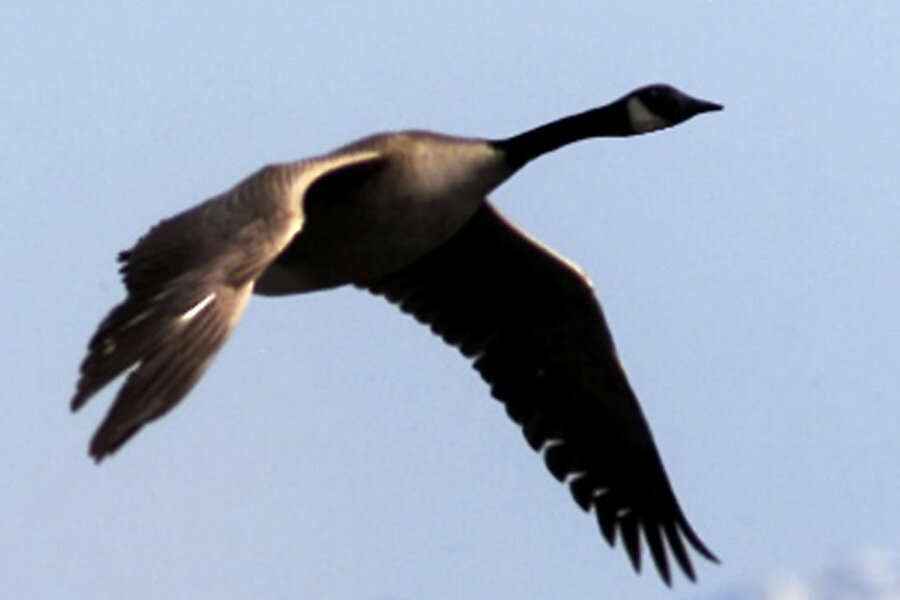Scientists discover that being a goose is actually kind of awesome
Loading...
Right now, a goose might be having more fun than you.
According to a study published today in Science, biologists have obtained new insight into the migratory habits of bar-headed geese – namely, that the birds treat mountains like roller coasters.
Each autumn, bar-headed geese migrate south from their breeding grounds in Mongolia to Southeastern Tibet or India. In 2011, before the annual flight, an international team of researchers surgically implanted 30 geese with equipment that measures body movement, heart rate, and altitude. Only 17 individuals could be recaptured after the migration, and only seven provided usable data. But the results were fascinating in that they seemed to contradict long-held assumptions about the geese’s migratory strategy.
“At the beginning we were just puzzled that there were so few reports of very high flight over the last 60 years,” Charles Bishop, the University of Bangor researcher who led the study, says. “We knew that these birds were especially well-adapted to fly in air containing very low oxygen, so we certainly expected to record some high flights. The question was, how high did they normally fly? For how long? And how difficult were such flights? How close to the limit did they have to go?”
Scientists used to think that bar-headed geese spent their entire migration at high altitudes, where only a favorable tailwind might aid them. But Bishop’s study, which follows up on previous research on the topic, shows that these birds change altitude as they traverse the Himalayas, hugging the mountainous terrain. By flying close to the ground as the mountainside rises and falls, their flight pattern resembles a roller coaster ride.
The geese do this for a number of reasons: firstly, because it’s hard work flying 20,000 feet in the air for over 1,000 miles. Bar-headed geese are known as one of the world’s highest-flying birds – a title biologists previously attributed to their impressive flapping strength and maximally efficient respiratory system. But it turns out that even these “superbirds” become tired at extreme altitudes, where oxygen is scarcer. Bishop’s research indicates that the geese actually prefer to seek lower altitudes, where more abundant oxygen means more economical flight.
“I think it is the most economical way to travel through the mountains,” Bishop said. “It might be justified for a bird to choose to fly a bit higher if there was a tailwind helping it cover the ground quicker. In this way it would reduce the travel time as well as reduce the overall energy cost for the journey. However, it appears that the winds were seldom blowing in the right direction to help the geese with their migrations, so the best thing to do is stay as low as possible and keep in the most dense air available.”
Dropping altitude doesn’t cost the geese much – it’s just gravity in action. But if you considered how much energy they expend flying upward, this sporadic and thrill-seeking flight technique might seem wasteful. This might be true, except for the fact that the migrating birds are aided by a phenomenon called orographic lift.
“If a wind hits a mountain ridge in the ground or a large wave at sea, then some of it will be deflected upwards and create an updraft,” Bishop said. “A bird can use this to help it when climbing – it increases [the bird’s] rate of climb, reduces the energy required to climb at some rate, or a bit of both. When flying horizontally, it decreases the energy that needs to be supplied to the air to fly along.”
As an orographic air mass rises, it expands and cools. Cool air dissipates body heat, making the geese’ arduous flight that much easier. Bishop found that bar-headed geese tend to fly highest at night, because the air is colder and richer with oxygen.
So is there some ambitious, future human use to the biomechanical strategies behind the bar-headed goose? Or is the takeaway merely that this is a uniquely powerful, finely-tuned, and really cool animal? Bishop says the latter is true, and he’s just fine with that.
“It is a spectacular migration through 1500 kilometers of the highest mountain area in the world,” Bishop said. “These birds do not appear to need to train before going on long migratory flights, nor do they need to acclimatize. Presumably, they not only get fit ‘naturally,’ but they also do not suffer from mountain sickness.”
“They could walk at the top of Everest with no difficulty and no ill effects,” Bishop added. “It would be fantastic if we could do this. The only Olympic games held at any significant altitude was that of Mexico City at only 2200 meters. At these games, men broke all world records below 800 meters – but at 1500 meters they slowed down, and the 3000 meter steeplechase upwards performances were 6% slower than world record time. These birds would probably not have noticed a thing.”
[Editor's note: The original version of this story misstated the number of kilometers travelled in a migration.]






